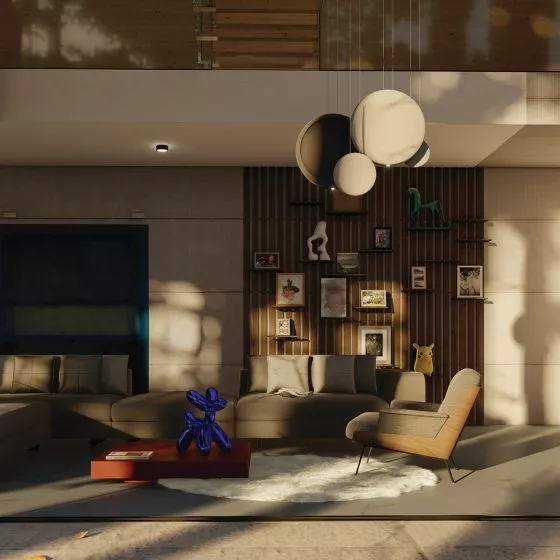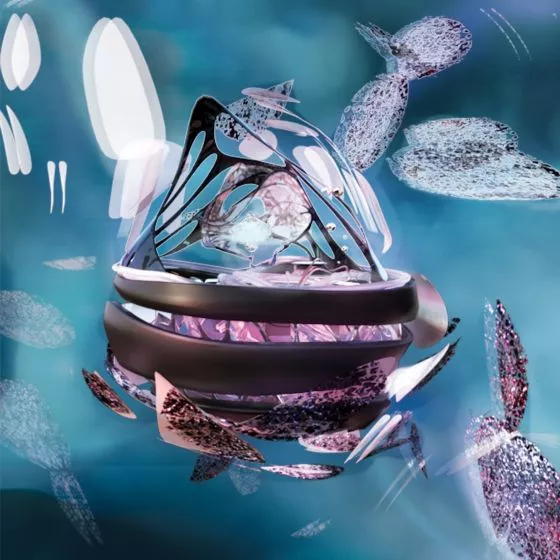We are living in the Anthropocene era, a time when human activity is so dominant that it is affecting the ecosystems and geological structure of the globe.
Man himself is destroying his planet. As an illustration of this problem and a critical design reflection, I chose the building of the torpedo factory in Babi Doły. Its ruins are a very clear symbol of man's drive to destroy. In my adaptation project, I have attempted to make them also a turning point, a laboratory that will demonstrate the possibility of renaturalizing urban space through architecture.
visualization of the pavilion overlooking the torpedo house
© Agnieszka Nyka
The project was created as a signal indicating that architecture should no longer be only for people, but also provide a framework for nature. The functional program of the premise is therefore based on two parallel goals. The first is to create conditions for the provision of natural habitats and the development of marine ecosystems, the protection of breeding grounds and the development of biodiversity; the second is to create an educational and visitor center.
In my project I am dealing with three buildings. I am carrying out the adaptation of a World War II torpedo house standing on the water. In addition, I am adapting the ruins of the hall building standing on the shore, part of the original torpedo testing facility. The third building is a new pavilion.
visualization of the adapted hall
© Agnieszka Nyka
The project is based on the concept of a ruin. Today's unique body of the torpedo house was created through a process of measured deconstruction by time and the elements. Using appropriate conservation techniques, I preserve its found form and prevent further destruction and leave it isolated from the land and inaccessible to people. The torpedo house is located on bird migration routes. I allocate it for use by birds, and design an innovative ornithological observatory. I applied a wooden frame to the torpedo house, providing a refuge place for birds. I generated its grid by imitating the symbolic position of the bird's hoardings around the torpedo house, and then transformed it by parametrically simulating the movements of waves and wind. The structure is inexpensive and easy to build. The frame is built from recycled oak or exotic wood, characterized by high strength and weather resistance. I am placing another such structure on the torpedo house, almost completely underwater, it will serve as a shelter for small marine ecosystems, now disappearing from the Baltic Sea. Scenes from the torpedo house will be recorded by cameras, transmitted in real time and displayed on screens in the exhibition part of the center, which I am designing on land.
axonometry of the torpedo house
© Agnieszka Nyka
This facility is a former torpedo assembly hall, which I am adapting into an exhibition and education center. In it I have created a hybrid space between the historical shell of the hall and the new volume inside. Trees, shrubs, mosses and grasses grow here. It is also used by people. It becomes a new, interactive part of the exhibition, which brings people closer to nature and popularizes the topic of ecosystem conservation. On the first floor level, I placed three independent cubic volumes, each with a different function. They contain a buffet and a workshop space. The cubes are connected to each other by a high underground floor, which houses the exhibition space. In addition to the traditional exhibition, I placed screens in it, on which a message from the torpedo house is projected, as well as glass pots - planted in them are the trees growing one floor above. In this way, I wanted to provide an opportunity to learn in depth about the processes taking place in nature. I designed various scenarios for visiting the hall and penetrating nature into the building.
visualization of the interior of the hall
© Agnieszka Nyka
The third building is a new information pavilion, which is the object linking the establishment. I designed it as an interpretation of the architecture of the bunker. Its facade is made of concrete, for which I also used aggregate from fragments of ruins and demolished buildings in the area. Its massing is due to the topography of the site and its location at the foot of the forest, and should not disturb the contemplative nature of the place. The pavilion houses an information desk combined with an exhibition space dedicated to the history of the site and displays bearing witness to human activities leading to destruction. The pavilion was planned in a strategic location, as the first building one encounters when entering the site. Wandering along a network of paths, one passes rain gardens and native coastal vegetation.
visualization of the interior of the pavilion
© Agnieszka Nyka
Agnieszka NYKA
Illustrations: © Author
































































